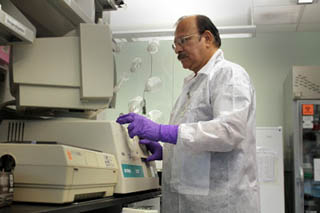Community website by MBC/Ernest Abrams. Call 808-739-9797 for advertising/sponsorship.
Kakaako - Honolulu, Hawaii
News Item- Powered by MBC NewsMaker
City Partners With University Of Hawaii To Expand Covid-19 Testing Capacity On Oahu
- Tweet
Expanded testing capacity is key to safely re-opening the economy.

HONOLULU – Mayor Kirk Caldwell and University of Hawaiʻi President David Lassner announced an agreement in principle today in front of the John A. Burns School of Medicine to dramatically expand COVID-19 testing capacity over the next several months as Honolulu’s economy re-opens. The partnership will establish the JABSOM Tropical Medicine Clinic Laboratory that will provide COVID-19 surge capacity for traditional diagnostic tests, establish a new “antibody” testing program, and develop new methods to test for COVID-19.
“We can’t truly find this virus and work to contain it if we aren’t looking for it,” said Mayor Kirk Caldwell. “From the beginning of this pandemic, testing has been one of the City’s three main focuses. The other two are contact tracing and quarantining. We believe much more testing needs to be done as we continue to get more of Oʻahu safely back to work. We thank the University of Hawaiʻi and the John A. Burns School of Medicine, along with Clinical Labs and Diagnostic Labs in partnership with our seven Community Health Centers, for working with us to increase testing capacity and make this transition to a more open way of life that is safe for the entire City and County of Honolulu.”
The new lab is being supported with $3.9 million in CARES funds from the City and County of Honolulu, and is being fast-tracked by the University of Hawaiʻi to be up and running in an estimated six weeks. The Rockefeller Foundation is also providing support to the project as part of a longer-term investment to ensure that Honolulu has surge capacity to handle subsequent waves of COVID-19. The Rockefeller Foundation has issued a national testing plan that calls for COVID-19 national testing capacity to raise from the current one million tests a week, to three million this summer, to thirty million by the fall in order for the nation to safely keep the economy open.
“We’re really excited about this opportunity to collaborate with the City and County, the Mayor and his team to leverage our facilities and our faculty expertise,” University of Hawaiʻi President David Lassner said. “This lab will also be a crucial component for our ability to open the University of Hawaiʻi for the fall.”
The partnership will provide 50,000 diagnostic COVID-19 tests available to Oʻahu residents through the end of the year, administered in partnership with Community Health Centers around the island. In addition, 49,000 COVID-19 antibody tests will be made available as part of a broader population study to identify patterns and levels of COVID-19 exposure locally. The lab has already obtained a Clinical Laboratory Improvement Amendment (CLIA) certificate of compliance from the State Department of Health and CLIA registration and will start securing equipment immediately.
“The UH John A. Burns School of Medicine is pleased to contribute facilities and scientific expertise to this joint effort with the City and County of Honolulu, and we believe that expanded testing capacity for on-island testing of COVID-19 will be important during the opening of the economy on Oʻahu,” said JABSOM Dean Dr. Jerris Hedges. “Contributing to new understandings related to this coronavirus infection will benefit the citizens and visitors to our island. We are pleased to help the Mayor and others in the City and County of Honolulu build a safer community as citizens return to work.”
The new UH lab capacity and test kits helps complement the City’s testing partnership with local private labs also announced today, and takes advantage of the strong research and data background at the University of Hawaiʻi.
The City-UH partnership will:
- Enable expanded, long-term COVID-19 test access for underserved, uninsured, and front-line workers who may require multiple tests for safety at their workplaces.
- Boost in-state private testing capacity to handle any future COVID-19 waves and surge periods.
- Strengthen the ability to secure 24 hour test results on island, and support rapid contact tracing and isolation of individuals who test positive for COVID-19.
- Identify patterns and levels of COVID-19 exposure through broad population antibody testing.
- Hire and train a medical laboratory technician and clinical laboratory scientist workforce that can build a pipeline of employment for the medical sector.
- Develop new approaches to test for COVID-19 that can reduce the cost of testing and decrease invasiveness—such as saliva-based testing instead of nasal swabs—allowing for broader testing to safely reopen and keep open the economy.
- Build longer-term capacity to identify, monitor, and diagnose COVID-19 variations and rare infectious diseases positioning Hawaiʻi to be on the leading edge of pandemic preparedness.
- Providing increased local capacity to do large group COVID-19 testing for both underserved populations (public housing projects, etc.), institutions (schools, etc.) and classes of workers (care homes, front-line workers) regularly.
To obtain more information on the City’s COVID-19 response, visit www.oneoahu.org
Questions? Ready for an appointment?
Featured Product/Service
- RELATED LINKS
Calendar
Check out things to do in Kakaako, Hawaii on the calendar of events.News and Newsletters
Keep up with the latest news and happenings in the Kakaako, Hawaii community.Featured Sponsors Offers
Great offers from our sponsors who support the Kakaako, Hawaii Community More...Kakaako, Hawaii Coupons & Discounts
Save money in Kakaako, Hawaii with these coupons.Kakaako, Hawaii Featured Pages
View our directory of feature pages showcasing all the great things Kakaako has to offer.About Kakaako - Honolulu Hawaii
Learn about Kakaako, Hawaii.About Kakaako Hawaii .com
Learn about Kakaako Hawaii .com website and its creator.
Please send questions about this website to
Copyright© 2014 - 2020 KakaakoHawaii.com. All rights reserved.
Terms of Use / Legal Disclaimer / Privacy Statement
Site Designed and Managed by MacBusiness Consulting
Terms of Use / Legal Disclaimer / Privacy Statement
Site Designed and Managed by MacBusiness Consulting
